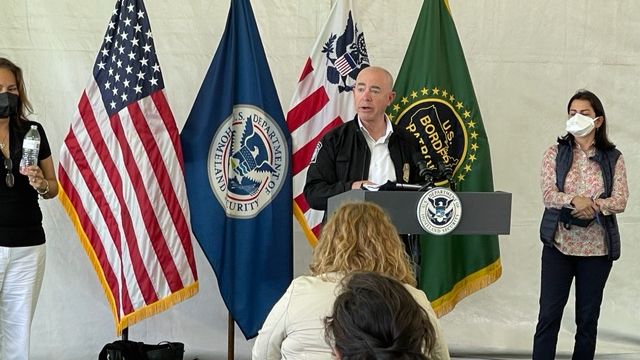Homeland Security Secretary Alejando Mayorkas visited a section of the U.S.-Mexico border in Texas on Friday, touring a center used to process children and families who have reached the United States in recent months and touting the administration’s work in the region so far.
The visit came as officials highlighted this week the lower number of migrant children held in border facilities, which aren’t meant for minors or long term care. There were 749 in Customs and Border Protection custody as of Wednesday, down from more than 5,000 in late March.
The average length of stay for minors in border patrol custody has also dropped to an average of 24 hours, senior administration officials told reporters Thursday, down from more than 100 hours in March.
Biden administration officials faced a record surge in migration toward the southwest border in the president’s first 100 days, including nearly 19,000 children in March alone.
While the vast majority of people who reach the border are being turned away under a pandemic-related restriction, the U.S. is accepting unaccompanied children.
To transfer those children out of harsh border facilities, both DHS and the Department of Health and Human Services have worked to open emergency shelters, which are supposed to provide medical services, recreation areas and better conditions for long term care. As of Wednesday, nearly 22,000 children were in shelters.
“We have made dramatic progress,” Mayorkas said at a press conference in Donna,TX on Friday after touring the processing facility there, though he admitted the need for much more work on the border.
“The challenge remains, as we all know all too well,” he said. “Immigration, including irregular migration, is a very dynamic challenge.”
Mayorkas was joined by Democratic members of Congress from the region: Reps. Lucille Roybal-Allard, Linda Sánchez, Sylvia Garcia, Nanette Barragan and Veronica Escobar.
The group was shown around the Donna border facility and told about how migrant children are processed, checked for COVID-19 and mental health needs, and asked for family information in order to connect them with a relative more quickly.
“We try to do all the leg work,” a representative for CBP told members of Congress inside.
Still, advocates have concerns about the conditions inside the longer-term shelters run by HHS, where children go after they are initially processed, especially since they are not state-licensed.
On a call with reporters Thursday, administration officials said they planned to keep the emergency shelters open “as long as they’re needed” while also working to speed up the release of children to their parents, family members or other sponsors within the United States.
“In the past two weeks of April alone we were able to increase the number of children that we united with parents or legal sponsors by 20%,” one official said, pointing to recent updates in policy and cooperation between DHS and HHS.
But as officials and the DHS secretary highlighted progress at the border on the U.S. side, the continued use of the Title 42 restriction — which relies on the pandemic — to deport most people has created confusion and sometimes-dangerous situations on the other side of the frontier.
“The border remains closed,” Mayorkas reiterated Friday.
The policy has led to makeshift camps in Mexico, where people wait at risk of violence or kidnapping, and some parents have also preemptively separated from their children in order to ensure they’ll be accepted into the U.S. if they arrive alone.
Judges have called the Title 42 policy illegal, and advocates have fought the order in court.
“It is a policy that I would like to see abolished as quickly as possible,” said Rep. Escobar (D-Texas), who joined Sec. Mayorkas on Friday’s tour.
Asked about the restrictions, Mayorkas blamed smugglers for putting people at risk.
“The smuggling organizations exploit these individuals and exploit their vulnerabilities,” Mayorkas said. “And that is why it is so important that the individuals who are thinking of leaving these countries understand the dangers of the journey.”
The DHS secretary also said the U.S. was working with Mexico’s government on the issue.
Earlier Friday, Vice President Kamala Harris spoke to Mexico’s president, Andrés Manuel López Obrador, as part of her diplomacy with Central American countries and the Biden administration’s promise to address the root causes of migration in the region.
“Most people don't want to leave home. And when they do, it is often because they are fleeing some harm or they are forced to leave because there's no opportunity in their home,” Vice President Harris said at the beginning of the meeting Friday morning. “And so, this is in our mutual interest to address some of these root causes.”
In the meeting, the two leaders discussed the need to “spur economic development in the Northern Triangle and southern Mexico” and to fight smuggling and human trafficking in the region, according to a White House statement on the call.
Vice President Harris is set to travel to Mexico to meet with the president and other officials in person on June 8.



